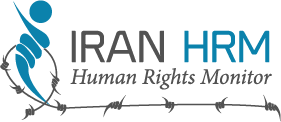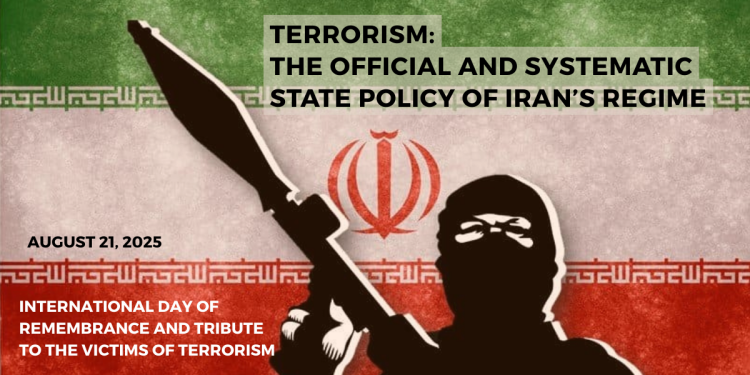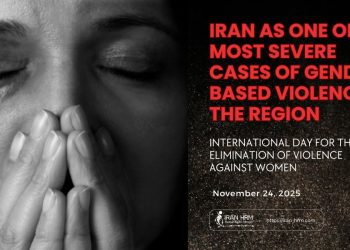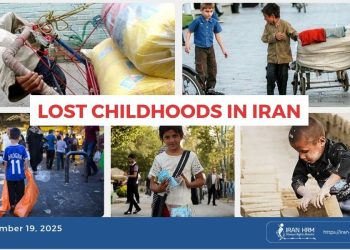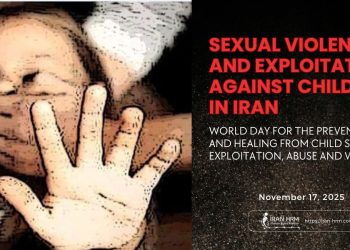Introduction
21 August, “The International Day of Remembrance and Tribute to the Victims of Terrorism,” is an occasion to honor the victims and survivors of this inhumane phenomenon. While terrorism has appeared in various forms worldwide, the ruling regime in Iran has institutionalized it as an official state terrorism policy since its very first days in power. Over the past four decades, this policy has taken thousands of lives inside Iran and endangered international security through extraterritorial terrorism and political assassinations abroad.
The Iranian Regime’s Extraterritorial Terrorism Policy
Multiple judicial cases have proven that the Iran regime terrorism is not random, but an organized state policy:
- Mykonos Trial – Germany (1997): The Berlin court explicitly identified regime leaders, including Ali Khamenei, Akbar Hashemi Rafsanjani, Ali Akbar Velayati, and Ali Fallahian, as those who ordered the assassination of Iranian opposition leaders.
- AMIA Bombing – Argentina (1994): Argentine courts confirmed the involvement of the Iranian regime and Hezbollah in the attack that killed 85 people and injured more than 300.
- Assadollah Assadi Case – Belgium (2018): An Iranian diplomat was sentenced to 20 years in prison for planning a bomb attack against the Iranian opposition rally in Villepinte, Paris.
- Attempted Assassination of Alejo Vidal-Quadras – Spain (2023): The Spanish court found evidence of Iranian regime proxies and hired mercenaries behind the attempt on the former Vice President of the European Parliament.
Common Patterns in the Regime’s State Terrorism
- Use of diplomatic cover and embassies to smuggle explosives and coordinate operations (e.g., Assadi case).
- Deployment of proxy networks and mercenary groups in target countries.
- Direct targeting of Iranian opposition figures abroad through political assassinations.
- Attacks on non-Iranians and civilian targets (e.g., AMIA bombing, Khobar Towers).
In this structure, the Quds Force of the IRGC served as the central operational arm of the regime’s state terrorism. In its early years, operational teams were dispatched directly by Quds Force units under the command of Qassem Soleimani. After scandals such as the Villepinte plot and the Mykonos assassinations, the regime increasingly relied on foreign mercenaries and criminal networks to obscure its direct involvement, as seen in the attempted assassination of Alejo Vidal-Quadras in Spain. Nevertheless, all operations were ultimately carried out under Soleimani’s command and on the direct orders of Ali Khamenei. This pattern demonstrates that terrorism is not incidental but an inseparable component of the regime’s machinery of governance.
International Condemnations
- European Union (2019): Placed Iran’s Ministry of Intelligence and several officials on the EU terrorism list.
- European Parliament: Issued repeated resolutions condemning Iran’s extraterritorial terrorism and political assassinations.
- United Nations: Special rapporteurs have highlighted Iran’s violations of international law and obligations under the ICCPR and other treaties.
- National Courts: The Mykonos trial (Germany), AMIA case (Argentina), U.S. courts on the Khobar Towers, and the Belgian court against Assadi all condemned the regime.
- Diplomatic Consequences: Following the Mykonos verdict, all EU member states withdrew their ambassadors from Tehran in protest.
Some of the Numerous Victims of Iran Regime Terrorism
- Abdul-Rahman Ghassemlou – Austria (1989): He was killed in Vienna on July 13, 1989, by three bullets fired at very close range in the room where negotiation took place, by the Iranian regime’s delegation.
- Dr. Kazem Rajavi – Switzerland (1990): University professor and representative of the Iranian Resistance in Geneva. He was the first to bring the issue of mass executions in Iran to the attention of the United Nations. On 24 April 1990, he was assassinated. Swiss prosecutors have reopened his case as a crime against humanity.
- Abdorrahman Boroumand – France (1991): was murdered in the lobby of his apartment building, Place Vauban, in Paris, April 18, 1991, by an unknown man who stabbed him five times to death and then managed to escape.
- Shapour Bakhtiar – France (1991): Bakhtiar and his secretary, Soroush Katibeh, were stabbed thirteen times and had their throats cut with knives by three assassins at their home in Suresnes, on August 6, 1991.
- Mohammad Hossein Naqdi – Italy (1993): A former diplomat who joined the Resistance, assassinated in Rome on 16 March 1993. His murder in the heart of Europe underlined the regime’s disregard for borders.
- Zahra (Faezeh) Rajabi and Ali Moradi – Turkey (1996): Rajabi, responsible for Iranian refugees, and her colleague were assassinated in Istanbul on 20 February 1996, spreading fear among exiled Iranians.
- Fereydoun Farrokhzad – Germany (1992) : His body was found in the kitchen of his apartment in Bonn, Germany on August 8, 1992, after neighbors reported barking by his two dogs. Farrokhzad had been killed violently, having been stabbed repeatedly.
- Ali Akbar Ghorbani – Turkey (1992): Kidnapped in June 1992, tortured to death by regime operatives—an example of combining abduction, torture, and assassination abroad.
- Hossein Abedini – Turkey (1990): Survived an assassination attempt in Ankara. Later testified: “My only fear was that the voice of the Resistance would be silenced.”
- Mykonos Restaurant Victims – Germany (1992): Sadegh Sharafkandi, Fattah Abdoli, Homayoun Ardalan, and Nouri Dehkordi assassinated on 17 September 1992 in Berlin. The Mykonos trial officially named top regime leaders as responsible. The verdict marked the first time a European court formally held the highest leaders of the Iranian regime accountable for state terrorism. The political impact was significant: all EU member states recalled their ambassadors from Tehran, leaving the regime in unprecedented diplomatic isolation.
The AMIA Case – In Absentia Trial of Regime Leaders
The 1994 AMIA bombing in Buenos Aires killed 85 and injured over 300 people. After decades of obstruction, on 25 June 2025, Argentine federal judge Daniel Rafecas ordered the in absentia trial of senior Iranian officials.
Those charged include Ali Khamenei (as principal authority per the Iranian Resistance’s demand), Akbar Hashemi Rafsanjani, Ali Fallahian, Ali Akbar Velayati, and Ahmad Vahidi.
Judge Rafecas emphasized that due to the crime against humanity nature of the attack, an in absentia trial is both legitimate and necessary to establish the truth. Argentine Minister of Security Patricia Bullrich also stated this mechanism is the only path to justice.
Joint Statement by 14 Countries (July 31, 2025)
On July 31, 2025, fourteen countries in Europe and North America — Albania, Austria, Belgium, Canada, Czechia, Denmark, Finland, France, Germany, the Netherlands, Spain, Sweden, the United Kingdom, and the United States — issued a joint statement strongly condemning the Iranian regime’s transnational terrorist activities.
The governments declared that Iranian intelligence agencies are increasingly collaborating with international criminal networks to kill, kidnap, and harass political dissidents, journalists, Jewish citizens, and current and former officials in Europe and North America. The statement emphasized that such operations are a blatant violation of national sovereignty, and the signatories pledged to act collectively to prevent these activities. They also demanded that the Iranian authorities immediately cease these hostile and unlawful actions.
This declaration highlighted once again that the mullahs’ regime’s policy of state terrorism is not only a domestic or regional issue, but a serious threat to global security and international order.
Media Coverage and Official Sources
This statement was widely covered in international media and institutions:
- U.S. Department of State – Joint Statement, 31 July
- UK Foreign Office (Wired Gov) – Statement on State Threats from Iranian Intelligence Services, 31 July 2025
- Center for Human Rights in Iran (CHRI) – Report on Iran’s Plots Abroad
- Reuters – 14 Countries Condemn Iranian Intelligence Threads
- Associated Press (AP) – News Report
Conclusion
Four decades of the mullahs’ regime’s extraterritorial terrorism — from the assassination of Dr. Kazem Rajavi and the Mykonos killings to the AMIA bombing and the conviction of Iranian diplomats for terrorist plots — have left thousands of victims in Iran and across the world. This policy has never been incidental but has remained a central pillar of the regime’s survival.
The joint statement by 14 countries on July 31, 2025, reaffirmed that the Iranian regime’s threats continue to endanger security in Europe and North America, underscoring the urgent need for coordinated multilateral action.
It is now imperative for the international community to recognize this state-sponsored terrorism as a crime against humanity and to establish binding mechanisms to hold the highest officials of the mullahs’ regime — particularly Ali Khamenei, as the ultimate authority behind this machinery of terror — accountable.
Failure to act decisively will only embolden the Iranian regime to continue its machinery of terror. The time for accountability is now.
